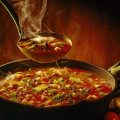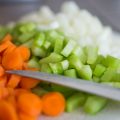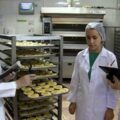What Is The Best Alternative To Safely Cooling Foods?
Quiz: What is the best alternative to safely cool food if you do not have a blast chiller?
Ans: Ice bath
Most people know that cooking food is an important step in food safety. But what about cooling food? Cooling gets less attention than cooking, but it can be every bit as important. The FDA has specific regulations for cooling food safely. These regulations are often called the two-stage cooling process since they’re usually taught to food workers in two stages. Understanding the regulations is critical for all food handlers.
Food safety is about managing risk. It’s about focusing on practices that address risk factors known to contribute to foodborne illness. Some practices are more critical or risky than others. Let’s focus on the proper cooling of hot food.
Improper cooling practices are a major cause of foodborne illness. In the United States between 1998 and 2008, improper cooling practices contributed to 504 outbreaks linked to restaurants and delis. Research conducted in 2010 by the Centers for Disease Control and Prevention (CDC) and several state health departments including the Minnesota Department of Health, shows the data collected indicates that many restaurants are not meeting the recommended cooling processes. A total of 420 restaurants (50 from Minnesota) participated in the study. Findings from these studies suggest that greater emphasis needs to be placed on the best practices of cooling hot food to reduce the risk of foodborne illness.
Temperature danger zone and 2-stage cooling
Microorganisms grow well in the temperature danger zone, 140–41 F. Within this range, temperatures between 125 and 70 F, allow for the most rapid growth of microorganisms. For this reason, food must pass through this range quickly. The 2-stage cooling method is approved in Minnesota.
Minnesota Food Code states cooked potentially hazardous food or TCS food (foods that need time and temperature control for safety) shall be cooled:
- From 140 to 70 F for 2 hours.
- And from 70 to 41 F or below within 4 hours.
Initial 2-hour cool is critical
The initial 2-hour cool is the most critical time period since the food is passing through the temperature range that supports the most rapid microorganism growth. If food has not reached 70 F within two hours, it must be reheated to 165 F for 15 seconds and then cooled again or thrown away.
Best practices for cooling food
Food needs help cooling down quickly; it can’t do it on its own. Factors that affect how quickly foods will cool down include:
- Size of the food item being cooled. The thickness of the food or distance to its center plays the biggest part in how fast a food cools.
- The density of the food. The denser the food, the slower it will cool. For example, chili will take longer than chicken noodle soup.
- Container in which food is stored. Stainless steel transfers heat from foods faster than plastic. Initially loosely wrap food items.
- Size of the container. Shallow pans with a product depth of fewer than 2 inches allow the heat from food to disperse faster than deep pans.
Don’t place hot food in the cooler or freezer
Food does not move through the temperature danger zone fast enough if the food is still hot when placed in the cooler or freezer or kept in bulk. Placing hot food in a cooler may raise the temperature of everything being held and may put it in the temperature danger zone.
Reduce the size of food and divide
Start by reducing the size or mass of food by cutting large food items into smaller pieces and dividing large containers into smaller containers.
Approved methods to cool food
Approved and efficient ways to cool food include:
- Ice-water bath and frequently stir the food. This promotes faster and more even cooling.
- Ice paddles (a plastic container filled with water and frozen) are used to stir food in an ice-water bath.
- Adding ice as an ingredient (if water is an ingredient).
- Blast or tumble chiller.
- Food containers can be loosely covered or uncovered (if protected from overhead contamination) when placed in cooling or cold holding equipment. This facilitates heat transfer from the surface of the food.
Monitor the cooling process
The only way to accurately know that time and temperature requirements are being met is by monitoring the process.






